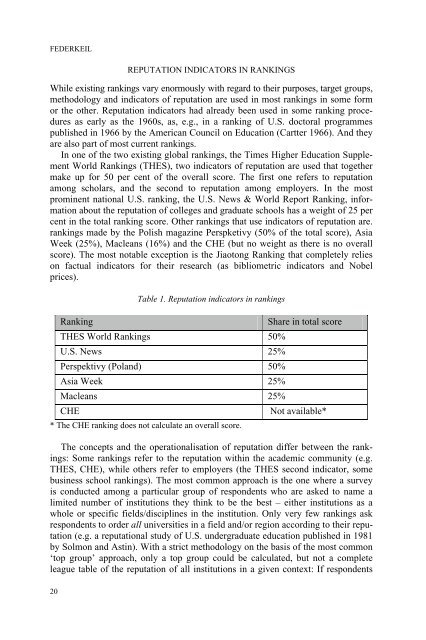University Rankings, Diversity, and the New ... - Sense Publishers
University Rankings, Diversity, and the New ... - Sense Publishers
University Rankings, Diversity, and the New ... - Sense Publishers
Create successful ePaper yourself
Turn your PDF publications into a flip-book with our unique Google optimized e-Paper software.
FEDERKEIL<br />
REPUTATION INDICATORS IN RANKINGS<br />
While existing rankings vary enormously with regard to <strong>the</strong>ir purposes, target groups,<br />
methodology <strong>and</strong> indicators of reputation are used in most rankings in some form<br />
or <strong>the</strong> o<strong>the</strong>r. Reputation indicators had already been used in some ranking procedures<br />
as early as <strong>the</strong> 1960s, as, e.g., in a ranking of U.S. doctoral programmes<br />
published in 1966 by <strong>the</strong> American Council on Education (Cartter 1966). And <strong>the</strong>y<br />
are also part of most current rankings.<br />
In one of <strong>the</strong> two existing global rankings, <strong>the</strong> Times Higher Education Supplement<br />
World <strong>Rankings</strong> (THES), two indicators of reputation are used that toge<strong>the</strong>r<br />
make up for 50 per cent of <strong>the</strong> overall score. The first one refers to reputation<br />
among scholars, <strong>and</strong> <strong>the</strong> second to reputation among employers. In <strong>the</strong> most<br />
prominent national U.S. ranking, <strong>the</strong> U.S. <strong>New</strong>s & World Report Ranking, information<br />
about <strong>the</strong> reputation of colleges <strong>and</strong> graduate schools has a weight of 25 per<br />
cent in <strong>the</strong> total ranking score. O<strong>the</strong>r rankings that use indicators of reputation are.<br />
rankings made by <strong>the</strong> Polish magazine Perspketivy (50% of <strong>the</strong> total score), Asia<br />
Week (25%), Macleans (16%) <strong>and</strong> <strong>the</strong> CHE (but no weight as <strong>the</strong>re is no overall<br />
score). The most notable exception is <strong>the</strong> Jiaotong Ranking that completely relies<br />
on factual indicators for <strong>the</strong>ir research (as bibliometric indicators <strong>and</strong> Nobel<br />
prices).<br />
Table 1. Reputation indicators in rankings<br />
Ranking<br />
Share in total score<br />
THES World <strong>Rankings</strong> 50%<br />
U.S. <strong>New</strong>s 25%<br />
Perspektivy (Pol<strong>and</strong>) 50%<br />
Asia Week 25%<br />
Macleans 25%<br />
CHE<br />
Not available*<br />
* The CHE ranking does not calculate an overall score.<br />
The concepts <strong>and</strong> <strong>the</strong> operationalisation of reputation differ between <strong>the</strong> rankings:<br />
Some rankings refer to <strong>the</strong> reputation within <strong>the</strong> academic community (e.g.<br />
THES, CHE), while o<strong>the</strong>rs refer to employers (<strong>the</strong> THES second indicator, some<br />
business school rankings). The most common approach is <strong>the</strong> one where a survey<br />
is conducted among a particular group of respondents who are asked to name a<br />
limited number of institutions <strong>the</strong>y think to be <strong>the</strong> best – ei<strong>the</strong>r institutions as a<br />
whole or specific fields/disciplines in <strong>the</strong> institution. Only very few rankings ask<br />
respondents to order all universities in a field <strong>and</strong>/or region according to <strong>the</strong>ir reputation<br />
(e.g. a reputational study of U.S. undergraduate education published in 1981<br />
by Solmon <strong>and</strong> Astin). With a strict methodology on <strong>the</strong> basis of <strong>the</strong> most common<br />
‘top group’ approach, only a top group could be calculated, but not a complete<br />
league table of <strong>the</strong> reputation of all institutions in a given context: If respondents<br />
20














